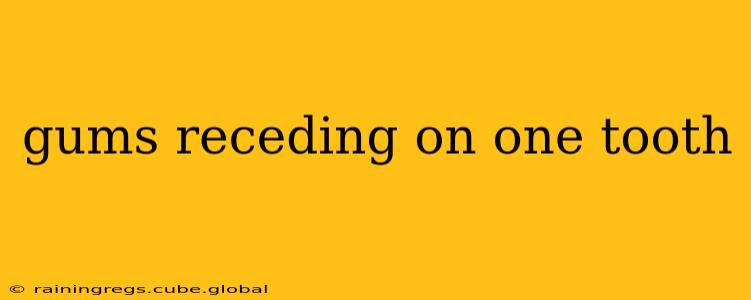Gum recession, where your gums pull back from your teeth, is a common dental problem. While it can affect multiple teeth, it's also possible to experience gum recession on just one tooth. This can be alarming, but understanding the causes, treatments, and preventative measures can help alleviate concerns and maintain oral health.
What Causes Gum Recession on One Tooth?
Several factors can contribute to gum recession on a single tooth. It's often not a single cause but a combination of factors that lead to this issue.
1. Aggressive Brushing: Brushing too hard or using a hard-bristled toothbrush can wear away the gum tissue over time, leading to recession. This is especially true if you concentrate your brushing efforts on one particular tooth.
2. Periodontal Disease (Gingivitis and Periodontitis): Gum disease, in its various stages, is a major culprit. Bacteria build up along the gum line, causing inflammation and infection. This inflammation can damage the tissues supporting your teeth, leading to recession. If left untreated, it can progress to periodontitis, a more severe form of gum disease that causes significant bone loss and can result in tooth loss.
3. Genetics: Some individuals are genetically predisposed to gum recession. Their gums might be naturally thinner or more susceptible to damage.
4. Tooth Grinding (Bruxism): The constant pressure from grinding or clenching your teeth can put stress on the gum tissue, particularly around the teeth experiencing the most pressure. This can lead to recession in those specific areas.
5. Misaligned Teeth (Malocclusion): Overly crowded or misaligned teeth can make it harder to clean effectively, increasing the risk of gum disease and recession. The pressure from one tooth rubbing against another can also contribute.
6. Piercings: Oral piercings, especially those placed near the gum line, can increase the risk of gum recession due to irritation and infection.
7. Certain Medical Conditions: Some medical conditions, such as diabetes and hormonal imbalances, can affect gum health and increase the susceptibility to gum recession.
What are the Symptoms of Gum Recession on One Tooth?
Recognizing the symptoms early is crucial for effective treatment. Common signs include:
- Visible lengthening of the tooth: The tooth appears longer than usual because the gum line has receded.
- Sensitivity to hot and cold: Exposed tooth roots are more sensitive to temperature changes.
- Redness or swelling of the gums: Inflammation indicates potential gum disease.
- Bleeding gums: Bleeding during brushing or flossing suggests gum irritation.
- Loose teeth: In severe cases, gum recession can lead to tooth loosening.
How is Gum Recession on One Tooth Treated?
Treatment options vary depending on the severity of the recession and the underlying cause. Your dentist will determine the best approach.
1. Improved Oral Hygiene: This is often the first step, involving proper brushing technique (soft-bristled brush, gentle circular motions), regular flossing, and the use of an antimicrobial mouthwash.
2. Scaling and Root Planing (Deep Cleaning): This procedure removes plaque and tartar buildup from below the gum line to treat gum disease.
3. Gum Grafting: For more significant recession, a gum graft may be necessary. This surgical procedure involves taking tissue from another area of the mouth (usually the palate) and attaching it to the affected area to cover the exposed root.
4. Guided Tissue Regeneration (GTR): This advanced technique involves placing a membrane between the bone and the gum tissue to encourage the regeneration of lost bone and gum tissue.
5. Orthodontic Treatment: If malocclusion is a contributing factor, orthodontic treatment (braces or aligners) may be recommended to correct the misalignment.
Can Gum Recession on One Tooth Be Prevented?
Preventing gum recession involves proactive measures to maintain optimal oral health:
- Gentle brushing: Use a soft-bristled toothbrush and brush gently in circular motions.
- Regular flossing: Floss daily to remove plaque and food particles from between your teeth.
- Regular dental checkups: Schedule regular visits to your dentist for professional cleanings and examinations.
- Mouthguard: If you grind your teeth, wear a mouthguard at night.
- Address underlying medical conditions: Manage any medical conditions that may affect gum health.
What if I notice gum recession on only one tooth?
If you notice gum recession affecting just one tooth, it's crucial to consult your dentist immediately. Early diagnosis and treatment can prevent further recession and potential complications, such as tooth loss. Your dentist can determine the underlying cause and recommend the most appropriate treatment plan to address your specific situation.
Is gum recession on one tooth a sign of something serious?
Gum recession on one tooth can be a sign of underlying issues, such as periodontal disease or aggressive brushing. While not always indicative of a serious condition, it warrants professional evaluation to rule out any significant problems and address the cause.
By understanding the causes, treatments, and preventative measures of gum recession on one tooth, you can take control of your oral health and maintain a healthy, confident smile. Remember, early intervention is key. Schedule an appointment with your dentist if you notice any signs of gum recession.
